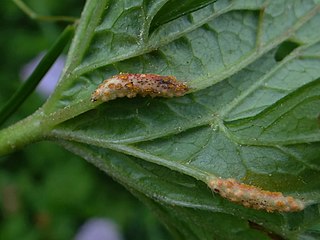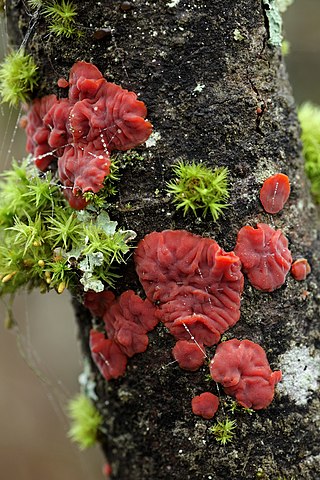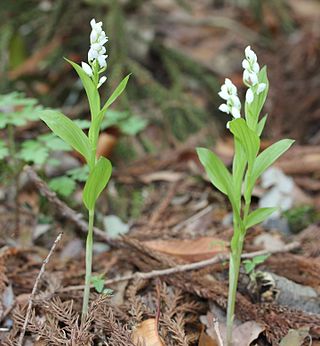
Crassocephalum is a genus the common names of whose members include ragleaf, thickhead, and bologi. Several species are raised as leaf vegetables and used for medicine, especially in West Africa. Similar to Senecio, but differing in never having ray florets. A calyculus of short bracts is present. The genus is typically thistle-like in appearance, but all parts are soft and not spiny.

Stem rust, also known as cereal rust, black rust, red rust or red dust, is caused by the fungus Puccinia graminis, which causes significant disease in cereal crops. Crop species that are affected by the disease include bread wheat, durum wheat, barley and triticale. These diseases have affected cereal farming throughout history. The annual recurrence of stem rust of wheat in North Indian plains was discovered by K.C. Mehta. Since the 1950s, wheat strains bred to be resistant to stem rust have become available. Fungicides effective against stem rust are available as well.

Wheat leaf rust is a fungal disease that affects wheat, barley, rye stems, leaves and grains. In temperate zones it is destructive on winter wheat because the pathogen overwinters. Infections can lead up to 20% yield loss. The pathogen is a Puccinia rust fungus. It is the most prevalent of all the wheat rust diseases, occurring in most wheat-growing regions. It causes serious epidemics in North America, Mexico and South America and is a devastating seasonal disease in India. P. triticina is heteroecious, requiring two distinct hosts.

Puccinia hordei is a species of rust fungus. A plant pathogen, it can cause leaf rust of barley, also known as brown rust of barley. It was originally found on the dry leaves of Hordeum vulgare in Germany.

Puccinia coronata is a plant pathogen and causal agent of oat and barley crown rust. The pathogen occurs worldwide, infecting both wild and cultivated oats. Crown rust poses a threat to barley production, because the first infections in barley occur early in the season from local inoculum. Crown rusts have evolved many different physiological races within different species in response to host resistance. Each pathogenic race can attack a specific line of plants within the species typical host. For example, there are over 290 races of P. coronata. Crops with resistant phenotypes are often released, but within a few years virulent races have arisen and P. coronata can infect them.
Puccinia kuehnii is a plant pathogen that causes orange rust disease of sugarcane. Orange rust was first discovered in India in 1914, but the first case of huge economical damage in sugarcane was registered in Australia in 2001. The first case in United States was in 2007 in Florida and has so far been the only state in the United States where sugarcane has been affected by this kind of rust. In order to treat the infected sugarcane at least three rounds of fungicide must be applied to the plant, costing growers $40 million a year. Currently scientists at the Agricultural Research Service are genetically analyzing the fungus that causes orange rust in order to help combat the problem.

Puccinia melanocephala is a fungus and plant pathogen, it is the causal agent of sugarcane rust. It was originally found on the leaves of a species of Arundinaria (cane) in Assam, India.

Puccinia is a genus of fungi. All species in this genus are obligate plant pathogens and are known as rusts. The genus contains about 4000 species.

Uromyces geranii is a fungus species and plant pathogen which causes rust on geranium plants.
Puccinia bromina is a fungus species belonging to the order of Pucciniales and the family Pucciniaceae. It was originally found on Bromus arvensis in Sweden.

Fuscoporia torulosa is a species of bracket fungus in the genus Fuscoporia, family Hymenochaetaceae. A wood-decay fungus, it causes a white rot of heartwood in dead and living hardwood trees in Europe, and in coniferous trees in North America.

Edwin Butterworth Mains (1890–1968) was an American mycologist. He was known for his taxonomic research on the rust fungi (Pucciniomycetes), the genus Cordyceps, and the earth tongues (Geoglossaceae).

Scutellinia olivascens is a species of apothecial fungus belonging to the family Pyronemataceae. This European fungus forms clusters of orange discs up to 1.5 cm in diameter on soil or rotting wood in summer and autumn. It is very similar to the common species Scutellinia umbrorum and can only be reliably identified by microscopic features.

Cytidia salicina commonly known as Scarlet Splash is a species of Fungus that is found growing on willows and other deciduous woody plants in Europe. The spores are 12-18x4-5 um.
Helicostylum elegans is a species of fungus in the family Mucoraceae.

Cocculus orbiculatus, the queen coralbead, is a species of woody vines. It is found from India east to Java.

Cephalanthera erecta, the erect cephalanthera, is a species of terrestrial orchid. It is found in China, Japan, Korea, Kuril Islands, Bhutan, Assam and eastern Himalayas.

Puccinia porri is a species of rust fungus that causes leek rust. It affects leek, garlic, onion, and chives, and usually appears as bright orange spots on infected plants.

Pleurotus albidus is a species of edible fungus in the family Pleurotaceae. Found in Caribbean, Central America and South America, it was described as new to science by Miles Joseph Berkeley, and given its current name by David Norman Pegler in 1983. It grows on trees such as Salix humboldtiana, other willows, Populus and Araucaria angustifolia, and can be cultivated by humans. Phylogenetic research has shown that while it belongs to P. ostreatus clade, it forms its own intersterility group.

Lentinus levis is a species of edible fungus in the family Polyporaceae. It was described by Miles Joseph Berkeley and Moses Ashley Curtis in 1853 and given its current name in 1915 by William Murrill. As a saprotroph, it can be cultivated. In nature it grows in subtropical to tropical climate. It is recognized and sometimes collected as a food by Huichol people of Mexico, although they prefer eating other, less chewy mushrooms. For a long time thought to be a member of Pleurotus genus, it has been moved to genus Lentinus.




















